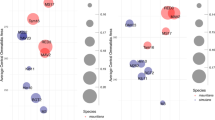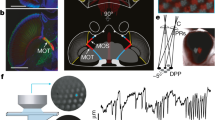Abstract
IN neural superposition eyes the signals of receptors pointing to one region in space are neurally pooled. The optical and neural organisation of these eyes yields an enhanced absolute light sensitivity while minimising the loss of visual acuity that accompanies pooling. In the compound eyes of flies (Diptera), this is achieved in the following way. The distal endings of seven retinula cells lie near the back focal plane of each lens1. Their light-sensitive structures, the rhabdomeres, are optically isolated from each other. The rhabdomeres of one ommatidium have different optical axes. The optical axes of seven rhabdomeres in seven adjacent ommatidia are parallel (Fig. 1a, ref. 2). The axons of such retinula cells (except the central ones, which pass through to the second optic ganglion) converge onto the same cartridge of secondary neurones in the first optic ganglion, the lamina3,4. Thus, each lamina cartridge ‘looks at’ one point in space. In one suborder of flies (Cyclorrhapha), to which the housefly Musca and the fruitfly Drosophila belong, the arrangement of rhabdomeres is asymmetrical (Fig. 1a). Eyes organised in this way are one form of neural superposition eyes2. Here, I provide evidence that a different kind of neural super-position eye exists in the Bibionidae, a family of flies of the suborder Nematocera. Bibionids are peculiar in being extremely sexually dimorphic in their visual system: the males have, in addition to small ‘female’ eyes, a pair of large dorsal compound eyes, functionally correlated presumably with the male habit of swarming and chasing females. These dorsal eyes differ from the eyes described in more advanced flies in two respects: the rhabdomeres are symmetrically arranged and the rhabdomeres with parallel optical axes are found in ommatidia √3 times further apart than adjacent ommatidia. The course of the retinula cell axons in the lamina differs accordingly.
Similar content being viewed by others
References
Kirschfeld, K. & Franceschini, N. Kybernetik 5, 47–52 (1968).
Kirschfeld, K. Expl Brain Res. 3, 248–270 (1967).
Trujillo-Cenóz, O. & Melamed, J. J. ultrastruct. Res. 16, 395–398 (1966).
Braitenberg, V. Expl Brain Res. 3, 271–298 (1967).
Franceschini, N. & Kirschfeld, K. Kybernetik 8, 1–13 (1971).
Strausfeld, N. J. Atlas of an Insect Brain (Springer, Berlin, 1976).
Franceschini, N. & Kirschfeld, K. Kybernetik 9, 159–182 (1971).
Pick, B., Biol. Cybernetics 26, 215–224 (1977).
Dietrich, W. Z. wiss. Zool. 92, 465–539 (1909).
Grenacher, H. Untersuchungen über das Sehorgan der Arthropoden, insbesondere der Spinnen, Insecten und Crustaceen (Vandenhoek and Ruprecht, Göttingen, 1879).
Ioannides, A. C. & Horridge, G. A. Proc. R. Soc. Lond. B190, 373–391 (1975).
Author information
Authors and Affiliations
Rights and permissions
About this article
Cite this article
ZEIL, J. A new kind of neural superposition eye: the compound eye of male Bibionidae. Nature 278, 249–250 (1979). https://doi.org/10.1038/278249a0
Received:
Accepted:
Issue Date:
DOI: https://doi.org/10.1038/278249a0
- Springer Nature Limited
This article is cited by
-
Target-oriented Passive Localization Techniques Inspired by Terrestrial Arthropods: A Review
Journal of Bionic Engineering (2022)
-
Digital cameras with designs inspired by the arthropod eye
Nature (2013)
-
Different retina-lamina projections in mosquitoes with fused and open rhabdoms
Journal of Comparative Physiology A (2005)
-
Optic lobes of the larval and imaginal scorpionfly Panorpa vulgaris (Mecoptera, Panorpidae): A neuroanatomical study of neuropil organization, retinula axons, and lamina monopolar cells
Cell & Tissue Research (1994)
-
The bright zone, a specialized dorsal eye region in the male blowflyChrysomyia megacephala
Journal of Comparative Physiology A (1989)





